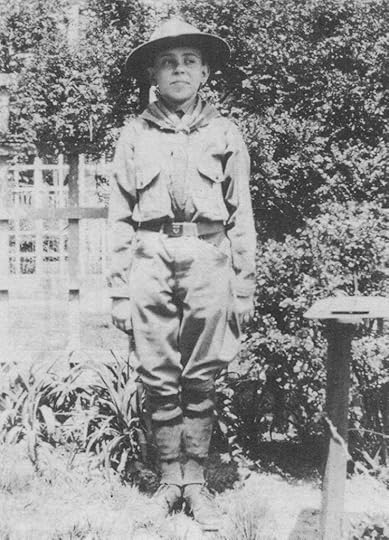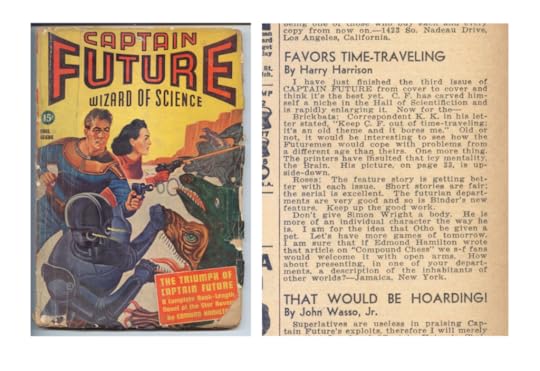Harry Harrison Centenary – Part 1: Early Life
Harry Harrison was born on the 12th March 1925 in Stamford, Connecticut. The name on his birth certificate was Henry Maxwell Dempsey, but he didn’t know this until he first applied for a passport as an adult. He was the only child of Henry Leo Dempsey and Ria Helen Dempsey (nee Kirjassoff). Henry Leo Dempsey was born in Oneida, New York, in 1888. He was a compositor and proof-reader working on the New York Daily News and elsewhere. Ria Kirjassoff was born in Riga, Latvia and grew up in St. Petersburg, Russia until her family emigrated to the United States. She was schoolteacher until she married.
In his memoir, Harry Harrison says little about his childhood except that it was ‘miserable.’ The Great Depression began in 1929 with the Wall Street stock market crash in October of that year. The Harrison family had moved to Brooklyn, New York in 1927, where Henry Leo adopted the surname of his stepfather, Billy Harrison. They moved to Queens in 1930. Like many other families, they struggled to survive financially and moved home – sometimes more than once in a year – to stay ahead of their creditors. During that period, a family could move into an apartment and pay a month’s rent. They would then stay for another three months, owing the rent, and then pack up all of their belongings and the ice man would come with his cart and move everything to a new apartment where the cycle would begin again.
 Harry Harrison aged six
Harry Harrison aged sixThere was one thing that helped alleviate the misery of those difficult early years. Harrison recalled the pleasure of discovering science fiction – which he referred to as ‘catching the rapture’ – in the introduction to World of Wonder (1969): “Science fiction is great stuff when you are young and has an impact not unlike the one received when putting the finger into a live electric light socket. Though for the most part I have only the vaguest of childhood memories, I do have one clear and sharp memory – that of reading my first science fiction story. The ancient cathedral-roofed radio, the sun in the window, the very texture of the carpet on which I lay, are all as clear as yesterday. My father gave me a copy of the old large-sized Amazing Stories, which appeared even larger in my seven-year-old hands, until it became a very bedsheet of a magazine. I plunged into those rocket ship filled, time machine, ancient alien, strange invention stuffed pages and emerged with my whole life changed. For the better, I sincerely hope, but changed it was indeed.”
In an afterword to Philip Francis Nowlan’s Armageddon 2419AD, Harrison wrote how the novel paved the way for the Buck Rogers comic strip – and the radio show that began with the famous words Buck Rogers in the Twenty-fifth Cent-tour-eeeeee. It’s clear from what he writes that Harrison enjoyed the comic strips more than Nowlan’s novel. And who but a young science fiction fan would recall something like this: “Woolworths did a good line of Buck Rogers devices, everything from small lead spaceships to stamped steel rocket guns. Mine broke instantly after purchase and I can’t remember if it clacked, popped or emitted a suction dart. The space helmet I had was more functional. It was made of some sort of fabric finished to look and feel like tan mouse fur and resembled a World War I flying helmet in most ways. It had an eye visor, broken off rather quickly, and stamped tin earphones. There was also a little vent on top whose function was never explained. I did love these future artefacts.”
Harrison also read the original Flash Gordon comic strips, begun in 1934 by Alex Raymond with the help of ghostwriter Don Moore. The young Harry could never have imagined that in a couple of decades time he would be writing Flash Gordon’s comic strip adventures.
As well as the comic strips and Amazing Stories, Harrison read other pulps – war titles, air war, railroad stories, Doc Savage, Operator 5, and The Spider.
In Hell’s Cartographers (1975), Harry Harrison wrote: “Loneliness is a word that has deepfelt meaning to me … I did not have a single friend among my classmates, nor did I belong to any gang or pack.” He read a lot, borrowing books from the Queens Borough Public Library. The stories of C.S. Forrester and John Buchan are named as favourite authors of that time. Things settled down when the family moved to Jamaica, Queens and Harry attended PS 117, Briarwood School. There he became friends with Henry Mann and Hubert Pritchard. These three engaged in a number of creative projects together in school and Harrison would again team up with Pritchard after the Second World War. It was at this school, in about 1937, that Harry Harrison began writing, a humorous musical play and poetry being mentioned.
Harrison became involved in science fiction fandom at the age of twelve. Hugo Gernsback, then editor of the magazine Wonder Stories, created the Science Fiction League to encourage and promote science fiction fan activities. The Queen’s chapter of the League was established in November 1937 and expanded to become the Greater New York branch in Spring 1938. In a brief account published in the Noreascon Three Souvenir Book (1989), Harrison wrote: “…Sam Moskowitz, Jimmy Taurasi, myself and about nine other juveniles had founded the Queens Science Fiction League…” He said that this took place ‘the year before’ the 1939 World Science Fiction Convention. Of that first Worldcon, Harrison wrote: “I took my cousin and we sneaked into the subway to save five cents. We must have really been broke because we even sneaked into Caravan Hall to save admission. Which was something like ten cents. I don’t remember the pros or the program – just the fanac. Joy of joys, an entire table filled with throwaways and sample fanzines. I loaded up…”
It was membership of the Science Fiction League that entitled Harry Harrison to join First Fandom, an organisation founded in 1959, with membership originally open to those who were active as fans before the First World Science Fiction Convention in July 1939.
 Harry’s letter in the Fall 1940 issue of Captain Future
Harry’s letter in the Fall 1940 issue of Captain FutureIn the Fall of 1940, Harrison had a letter published in Captain Future magazine. And he contributed to at least one fanzine, Gerry de la Ree’s Sun Spots, providing an illustration for the May-June 1941 issue. A note beneath the image states: ‘The original of “Robot” is better than the above, as it was difficult to stencil parts of it’ – a reference to the mimeograph process used to duplicate fanzines in the pre-photocopier era.
 Harry’s drawing from the 1941 Sun Spots fanzine
Harry’s drawing from the 1941 Sun Spots fanzineHarrison and Hubert Pritchard attended Forest Hills High School which opened at the beginning of 1941. The attack on Pearl Harbor took place in December of that year. Harry Harrison was sixteen years old. The Second World War overshadowed Harrison’s high school years – he and his male friends knew they would be drafted on their eighteenth birthdays. They referred to themselves as the ‘no hope’ class. Reflecting on his education years later, Harrison said: “I did pretty rotten at school – or rather, I did well at things I enjoyed: I got the highest marks in class for Science and English, and the lowest marks in Spanish.”
 Harry’s yearbook photo from 1943
Harry’s yearbook photo from 1943 Graduating from high school in 1943, Harrison decided that he didn’t want to drown, so he’d prefer to stay out of the navy, and as he didn’t want to get shot, he’d try and avoid the infantry. He would try and persuade the draft board to put him in the air force. After leaving school, he worked as a box boy in Macy’s department store during the day and used the money to attend night school at the Eastern Aircraft Instrument School, in Newark New Jersey. He received a CAA license as an Aircraft Instrument Technician just before he was drafted. When his call up came, he was sent for basic training in the United States Army Air Corps.
NEXT: In the Army Now
Paul Tomlinson is the author of over a dozen novels and books about writing genre fiction. www.paultomlinson.org
Harry Harrison's Blog
- Harry Harrison's profile
- 1036 followers



